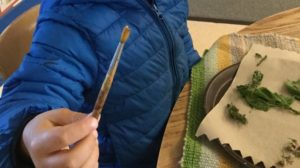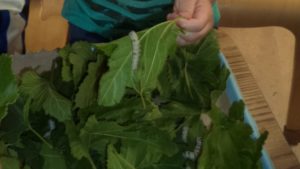How To Hatch Silkworm Eggs – Exploring The Exciting Lifecycle Of A Silkworm
Over the past 20+ years of teaching in a classroom I have introduced children to the lifecycle of silkworms year after year. It is one of those activities that it just as exciting for the teachers as it is for the children. When I pull the silkworm eggs out of the back of the refrigerator, it is reminiscent of a holiday that comes once a year.
Raising and caring for silkworms provides a wonderful learning experience for young children and adults alike. You can explore the lifecycle of a silkworm whether you are at home or in a classroom setting. First, start by preparing the eggs for hatching. Next, nurture the worms as they eat, grow, and spin into a cocoon. Finally, observe the cocoon as the worm metamorphosis into adult moths.
It is hard to imagine that silk comes from a worm. Silk is obtained from processing the silkworm’s cocoon. Silk cultivation dates back in time for centuries and across many different cultures. This is truly an amazing gift from nature and such a fun activity for a class of children. Growing and nurturing silkworms builds on children’s natural curiosity, enabling interaction, questioning, problem-solving, communication, and reflection.
An example of exploration within a classroom:
I start the project off by taking time to observe a piece of silk.
During group time we passed around a piece of silk cloth and then we talked about how they thought this cloth was made? The children had a lot of ideas. We made a chart to document our ideas. Then we talked about how this is actually made from something that comes from a living creature. The children were amazed and they wanted to know how this could be possible. We then showed pictures of silkworms and also a chart showing the lifecycle of a silkworm.
You will need to prepare a silkworm habitat by placing some mulberry leaves in a small terrarium or a shoebox. You can line it with some paper towels to make it easy to clean. Place the eggs/or worms near the mulberry leaves. The eggs are yellow when they are laid and are just about the size of an ink dot. The eggs take about 14 days to hatch. The eggs will turn dark brown or black when they are ready to hatch.
On the following day we brought out the silkworm eggs to observe with magnifying glasses. When we started to look at our eggs a little closer we discovered that some of the eggs had already started to hatch and the worms looked like tiny pieces of black thread. Many of the children were very engaged as they sat patiently for a chance to see the worms hatching out of the eggs.
Once the worms hatch they are now in the larvae stage and are only about 1/8th of an inch long. Silkworms ONLY eat mulberry leaves so you will need to find a good source of fresh mulberry leaves. Once the new leaves start to appear on the mulberry trees in the springtime then it is a good time to start raising your silkworms. (TIP: If you have eggs stored away in refrigerator do not bring them out until you can find a sufficient amount of food). You will have to find a sufficient source of fresh mulberry leaves to use throughout their lifecycle. If you are not able to locate a source of fresh mulberry leaves then you can order a container of silkworm chow online. Silkworm chow consists of either powdered or ground mulberry leaves. It is an excellent substitute when fresh mulberry leaves are not available or for the convenience of having the silkworm’s food readily available.
Next we showed the children how to move the silkworms gently from a dried leaf onto a fresh mulberry leaf using a watercolor paintbrush. The children felt the soft bristles and agreed that this would be a gentle brush to use on the silkworm’s body.
The silkworms will need to eat some fresh leaves daily and they need to be moved from the dry leaves onto new leaves. This becomes a popular activity and some of the children will want to return day after day to check on the growth of the silkworms. They may even decide to read books to the silkworms so you can place a variety of related books nearby.
Feeding and caring for the silkworms continues for 20 – 30 days and then when the worms are about the size of your small pinky finger then they will start to spin a cocoon.
The children were excited to find another huge change taking place when they discovered that the silkworms were spinning. The cocoons are spun with one single silk thread that becomes the protective housing that the silkworm encases itself in. The cocoon will look like a small oval shaped cotton ball. It is during this stage that the cocoons are turned into silk by a process that unravels the thread. You can have the silkworms continue their complete lifecycle in order for the children to observe all of the stages of their lifecycle. You will need to create an environment for the next silkworm stage.
We had the children cut paper egg cartons, toilet or paper towel rolls (cut into 1-2 inch long segments) to build structures for the silkworms to spin their cocoons. When the silkworms spin their cocoons within the paper tubes or cartons then it is an easily transportable way to save your silkworm eggs once the moths hatch, mate, and start to lay eggs.
The silkworms will be in their cocoons for 2-3 weeks. Next they go through their metamorphosis stage and emerge as silk moths. The moths may beat their wings but they do not fly. They do not need to be fed because they do not eat. They will find a mate, lay eggs, and then die. The lifecycle will then continue. You can pause the lifecycle at this point by storing the eggs that were laid into a jar and placing them into a cool dark place such as the back of a deep cabinet or refrigerator. You should be able to save them until the following springtime when they will start to hatch again!
Some important things to think about:
Q: Where to obtain silkworms or eggs?
A: Can typically find them being passed around from one teacher to another. The moths typically lay hundreds of eggs each.
Silkworms and silkworm eggs can also be ordered online.
Q: What do you need in order to keep silkworms?
A: Some things that you may want to gather:
- A terrarium or shoebox
- Magnifying glass
- Small paintbrush
- Silkworm lifecycle chart
- Books about silkworms
- Recycled paper towel / toilet paper rolls (cut into one inch segments).
Q: Where to find mulberry leaves?
A: It is essential to locate a mulberry tree in order to have a fresh source of leaves. If that is not possible then silkworm chow can be ordered from some online vendors. The silkworm chow is made from ground mulberry leaves. It is like baby food for silkworms and it comes in a tub that can be stored in the refrigerator. They also have powdered silkworm food.
Q: How to save the eggs for next year?
A: Place the eggs into a jar or bag and placing them into a cool/dry/dark place such as the back of a deep cabinet or refrigerator. You can save them for at least one year.
Q: How long does it take for the silkworm cocoon to hatch?
A: It takes roughly 10 days from the cocoon completion for the moth to emerge.









